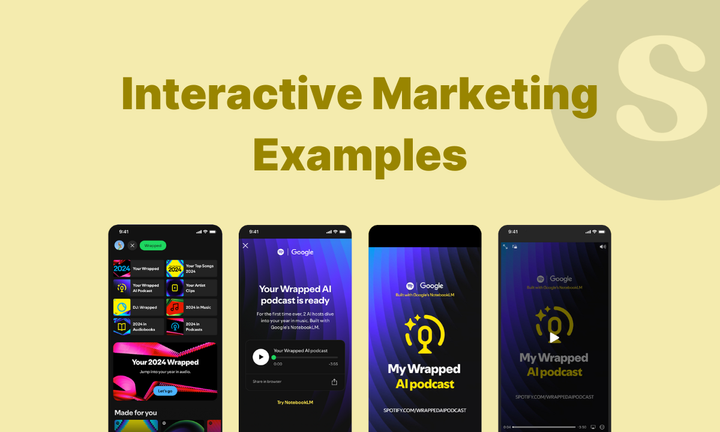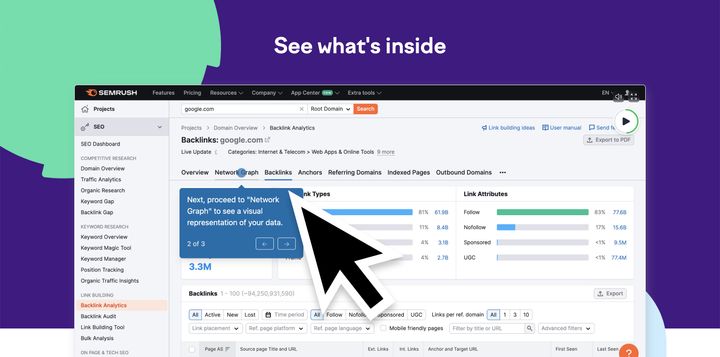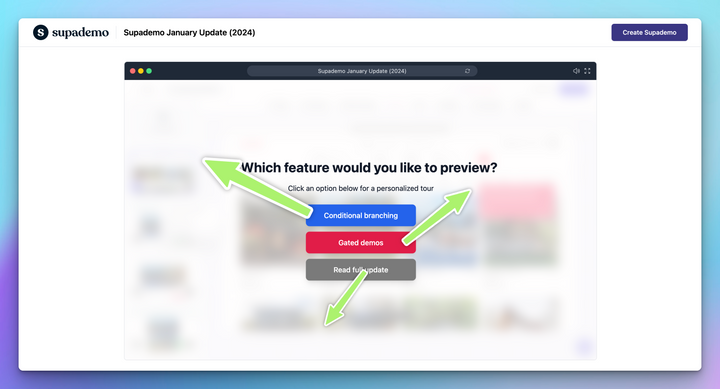Looking for the best interactive marketing examples? This guide breaks down 12 real-world campaigns—from quizzes and AR try-ons to interactive demos and memes—that turn passive audiences into active participants. Discover how brands like Spotify, Duolingo, and Notion use interactivity to boost engagement, build community, and drive conversions—and how you can do the same with Supademo.
Audiences today don’t want to sit back and consume content. They want to engage with it. From quizzes and AR try-ons to interactive demos and memes, the most effective marketing invites people to click, explore, and shape the experience themselves.
That is what makes interactive marketing so powerful. By turning campaigns into two-way experiences, brands build stronger connections, spark higher engagement, and create moments people remember. In this guide, we’ll explore 12 real-world examples you can adapt to your own strategy.
What is interactive marketing?
Interactive marketing is a two-way approach where brands create content that encourages audience participation rather than passive consumption. Instead of simply pushing messages, it invites users to click, answer, explore, or personalize their experience.
This can take the form of quizzes, polls, interactive demos, AR try-ons, or gamified campaigns. By turning audiences into active participants, interactive marketing builds stronger connections, increases engagement, and helps brands stand out in crowded digital spaces.
Top 12 interactive marketing examples
Now that we’ve covered what interactive marketing is and why it works, let’s look at how leading brands are putting it into action. These 12 examples show the many ways you can invite participation—whether it’s through gamified campaigns, AR try-ons, or creative offline activations.
Each one proves that when you give people a chance to interact, they’re far more likely to remember your brand and take the next step.
| Interactive Marketing Example | Brand | Key Idea | Takeaway | |
|---|---|---|---|---|
| 1 | Interactive Product Demos | Senja | Let prospects explore your product through guided, clickable demos. | Transform static presentations into hands-on experiences that boost conversions. Tools like Supademo make this effortless. |
| 2 | Interactive Quiz Marketing | BuzzFeed | Engage users with quizzes that provide personalized results and insights. | Make marketing feel fun while gathering valuable audience data. |
| 3 | Interactive Data Dashboards | Spotify | Turn raw data into personalized, shareable visual stories. | Transform analytics into cultural moments people love to share. |
| 4 | Interactive Calculators | HubSpot | Allow users to input data and get instant, customized insights. | Provide value upfront and qualify leads naturally. |
| 5 | User-Generated Content (UGC) | GoPro | Empower users to create authentic content around your product. | Build trust and community by spotlighting real customer stories. |
| 6 | Gamified Ads | Duolingo × Squid Game | Blend entertainment with interaction to make ads playful and viral. | Use pop-culture tie-ins to spark engagement and recall. |
| 7 | Interactive Storytelling | The Pudding | Let readers explore stories through visuals, clicks, and choices. | Convert static articles into immersive, scroll-based experiences. |
| 8 | AI Chatbots | Sephora | Guide users with conversational AI and real-time recommendations. | Deliver instant, personalized engagement while automating support. |
| 9 | AR Experiences | IKEA Place | Use augmented reality to let users “try before they buy.” | Reduce uncertainty and make online shopping more immersive. |
| 10 | QR Code Campaigns | Taylor Swift (TTPD) | Use QR codes to unlock exclusive or evolving content experiences. | Build anticipation and community through interactive discovery. |
| 11 | CGI Marketing | L’Oréal | Use CGI visuals to create bold, share-worthy brand moments. | Bring your product story to life with high-impact digital creativity. |
| 12 | Meme Marketing | Notion | Tap into humor and trends your audience already engages with. | Foster community by turning followers into co-creators. |
1. Interactive product demos | Senja
Interactive demos let prospects explore your product in a hands-on way. Instead of watching a static video or scrolling through screenshots, users click through real workflows and see exactly how features work.
Senja, a testimonial platform, weaves interactive demos across its customer journey. On its homepage, visitors can explore a product tour right away. New users get onboarding demos tailored to their goals. In sales, the team shares personalized demos to showcase integrations. This creates a consistent “show, don’t tell” experience across marketing, onboarding, and outreach.
What we like:
- Hands-on exploration: Buyers test-drive the product instead of reading about it.
- Aligned with modern B2B behavior: Today’s buyers want to self-educate before engaging with sales.
- Consistency across touchpoints: Marketing, onboarding, and sales all use the same interactive format, reducing friction.
- Scalable personalization: Reps can tailor demos for specific prospects without creating custom decks each time.
- Engagement data: Every click gives Senja insights into what features resonate, informing product and sales strategy.
Impact:
Senja’s homepage demo has attracted more than 100,000 unique viewers with a 14% engagement rate, proof that interactive demos hold attention and convert interest into action.
The takeaway? Senja’s approach proves that interactive demos are more than a nice-to-have. They’re a scalable way to educate prospects, build trust, and drive conversions.
“The ability to create and share collections and Showcases is awesome. I can easily create and group together multiple short demos as a ‘starter kit’ for our new users.”
- Oliver Meakings, Co-founder
If you want to replicate this strategy, Supademo makes it simple to create, personalize, and track demos across your marketing, sales, and onboarding workflows. Create your first interactive demo with Supademo for free!
2. Interactive quiz marketing | BuzzFeed
An interactive quiz is a fun, clickable experience that asks people questions and gives them a personalized result.
BuzzFeed transformed quizzes into cultural moments. Their content draws on pop culture, nostalgia, fandoms, and self-identity in ways that feel personal, playful, and never salesy.

What we like:
- Viral engagement: BuzzFeed's quizzes like "What City Should You Actually Live In?" achieve 96% completion rates and over 20 million views.
- Shareable by design: Results are made for screenshots and social sharing, which sparks organic conversations online.
- Smart data collection: Users willingly share preferences through social logins while enjoying entertainment-first experiences
- Psychology-driven: Taps into self-discovery desires, making marketing feel like fun rather than selling
The takeaway? When done well, quizzes are more than entertainment—they’re a powerful tool for capturing attention, collecting data, and sparking word-of-mouth growth.
3. Interactive data dashboards | Spotify
An interactive data dashboard is a visual experience that turns raw data into something people can explore and personalize. Instead of static charts, it presents insights in a way that feels dynamic, engaging, and tailored to the individual.
Spotify Wrapped is the most iconic example. Each year, Spotify delivers users a personalized dashboard that highlights their top songs, artists, and listening habits. It transforms data into a shareable story that feels like a gift rather than just analytics.

What we like:
- Personalized storytelling: Everyone’s Wrapped looks different, making it feel uniquely yours.
- Data made fun: Dry stats are reimagined as playful graphics and animations.
- Social magnet: People proudly share their Wrapped on social media, turning private habits into public conversation starters.
- FOMO effect: Non-users see the buzz and feel compelled to join in next year.
- Brand reinforcement: Spotify positions itself not just as a music platform, but as a cultural trendsetter.
What does it mean for you? Spotify Wrapped proves that when you turn data into a story, people don’t just consume it—they celebrate it. Interactive dashboards can elevate even the driest information into a viral moment.
4. Interactive calculators | HubSpot
Think of an interactive calculator as a shortcut to clarity. Instead of reading generic advice, you plug in your own numbers and instantly see insights that apply to your business.
HubSpot’s Ad Spend ROI Calculator is a great example. Enter your ad budget, conversion rates, and customer value, and it shows you exactly what kind of return you can expect. No complicated spreadsheets. No guesswork. Just a clear picture of whether your ad dollars are working hard enough.

What we like:
- Actionable insights: The tool translates complex marketing math into clear, easy-to-read results.
- Personal relevance: Marketers see how ROI changes based on their actual inputs, not generic benchmarks.
- Educational: It guides users to think about metrics like lifetime value and conversion rate.
- Lead-friendly: Users can opt in for deeper resources, giving HubSpot qualified leads.
- Trust-building: HubSpot positions itself as a helpful partner rather than a pushy vendor.
How can you implement? If you’re in B2B, think about what numbers your audience struggles with—ROI, pricing, savings, or benchmarks. Turning that into an interactive calculator gives you a powerful lead magnet that attracts, educates, and qualifies prospects all at once.
5. UGC marketing | GoPro
User-generated content (UGC) is content created by customers, not brands. It has become one of the most powerful ways to build trust, especially with younger audiences who crave authenticity over polished ads.
GoPro has turned this into an art form. Instead of focusing on studio campaigns, the brand highlights real videos captured by its customers—whether that’s surfing giant waves, mountain biking down cliffs, or simply capturing family adventures.

Here’s why GoPro’s UGC strategy soars higher than a skydiver at 10,000 feet:
- Authenticity: Raw, unfiltered footage from real users beats glossy brand shoots.
- Community power: Customers feel like part of a movement, not just buyers.
- Infinite content stream: Every customer video doubles as fresh marketing material.
- Social buzz: When users proudly share their own footage, GoPro’s reach multiplies organically.
The result? GoPro turned customers into its biggest advocates. The lesson for any brand, especially in B2B, is clear: your users are not just buyers, they’re also your best storytellers.
6. Gamified Ads | Duolingo’s “Learn Korean or Else” x Squid Game Campaign
A gamified ad injects playful, game-like elements into advertising. Instead of just showing a message, it creates an experience that involves viewers, surprises them, or urges them to play along.
Duolingo’s “Learn Korean or Else” campaign shows how powerful this can be. Teaming up with Netflix ahead of Squid Game Season 2, the brand turned language learning into a cheeky chase. The Duolingo owl, Duo, dressed as a Squid Game guard, appeared in ads, TikTok filters, billboards, and even a K-pop remix track to invite fans into the game.
What we like:
- Pop culture crossover: Duolingo tapped into Squid Game’s global popularity to make language learning feel fun and urgent.
- Playful immersion: From a TikTok filter that mimicked Red Light, Green Light to dance challenges, users didn’t just watch, they played.
- Multi-channel reach: The campaign stretched across social media, billboards, music videos, and influencer content, creating constant touchpoints.
- Humor with purpose: The campaign’s tone (“learn Korean or else”) turned a cultural moment into actionable interest in the app.
How can you implement this? Duolingo’s Squid Game campaign proves that when marketing feels like play, people want to join in. Think about cultural trends or moments your audience already cares about. Could you tie your product to a playful challenge, a trending meme, or even a filter?
You don’t need a Netflix budget to create something interactive and shareable. Small, clever gamified ads can turn passive viewers into active participants.
7. Interactive storytelling | The Pudding
Interactive storytelling takes a story and turns it into something people can click, scroll, or explore at their own pace. Instead of passively consuming information, readers uncover the narrative themselves through visuals, data, or choices.
The Pudding is a digital publication that has mastered this craft. Known for its quirky, data-heavy explainers, it creates interactive essays on pop culture, music, and social trends. Examples include visual breakdowns of “How Bad Is Your Streaming Music?” or stories where readers explore the language of hip hop lyrics, fashion trends, or movie dialogue through interactive graphics.

What we like:
- Exploration over reading: Stories unfold as readers scroll, click, or filter data themselves.
- Data made delightful: Complex subjects like gender in film dialogue or music listening habits are made fun through playful visuals.
- Personalized connection: Many stories let users plug in their own data (like Spotify listening) to make the narrative about them.
- High shareability: Interactive essays are unique enough that people want to share their results or favorite findings.
- Learning through play: Readers retain insights better when they discover them firsthand.
The takeaway? If you’re in B2B or SaaS, you don’t need to reinvent journalism. But you can borrow The Pudding’s approach: turn data or research into an interactive experience. Instead of publishing a static whitepaper, build a scroll-based story or clickable dashboard that lets prospects explore insights in a hands-on way.
8. AI chatbots | Sephora Virtual Artist
AI chatbots are conversational tools that let users interact with a brand in real time. Instead of searching or clicking through menus, people can ask questions, get recommendations, and even complete tasks through natural conversation.
Sephora’s Virtual Artist is a strong example. Beyond answering FAQs, it uses AI to recommend products, let customers “try on” makeup virtually, and guide them through a purchase. It feels less like browsing a catalog and more like chatting with a personal assistant.
What we like:
- Personalized guidance: The bot tailors recommendations to each customer’s needs and preferences.
- Frictionless support: Customers get instant answers without waiting on human agents.
- Interactive shopping: Virtual try-ons and guided routines make the experience fun, not transactional.
- Time and cost savings: AI handles repetitive questions, freeing humans for complex support.
- Always on: Customers can engage anytime, boosting convenience and loyalty.
What does it mean for you? If you’re in B2B, SaaS, or e-commerce, chatbots can go beyond basic customer support. You can use them to qualify leads, guide prospects to the right plan, or onboard new users with step-by-step walkthroughs. The key is to design conversations that feel helpful and human, not robotic.
9. AR experiences | IKEA Place
Augmented reality (AR) experiences let customers overlay digital objects into the real world using their phone or tablet. Instead of imagining how something will look, they can see it right in their own space.
IKEA Place is a standout example. The app allows shoppers to visualize true-to-scale furniture in their homes before buying. From couches to bookshelves, users can “place” items in their rooms, rotate them, and explore how they fit—bridging the gap between browsing online and shopping in-store.
What we like:
- Try before you buy: AR removes uncertainty, helping customers feel confident in their purchase.
- Seamless experience: Shoppers explore products in the app without needing to visit a store.
- Reduced returns: Fewer mismatched purchases mean lower return costs.
- Memorable interaction: Customers feel like they’re experimenting, not just scrolling.
- Brand innovation: IKEA reinforces its image as a design-forward, customer-first brand.
10. QR Code marketing | Taylor Swift’s “TTPD” QR Code Campaign
A smart QR code campaign uses scannable codes as gateways to exclusive content or playful experiences. Taylor Swift’s TTPD (The Tortured Poets Department) campaign is a perfect example.
Just before her album launch, massive QR code murals appeared across 12 time zones. Each scan revealed a new YouTube Short, with fans piecing together letters that spelled “Fortnight.” The campaign generated global anticipation, endless fan theories, and viral buzz online.

What we like:
- Mystery and anticipation: Fans scanned not for discounts but for clues. The payoff felt like solving a puzzle.
- Dynamic experience: The same QR code revealed different content over time, rewarding repeat scans.
- Community power: Swifties collaborated worldwide to decode the hidden message, fueling the hype.
- Omnichannel reach: From city murals to TikTok clips, the campaign lived both online and offline.
How can you implement this? Taylor Swift’s QR campaign shows how a simple code can become an interactive story. You don’t need a Taylor Swift-sized audience to borrow this idea. Use QR codes to create small but memorable journeys like a scan-to-unlock case study, a daily content reveal, or an event scavenger hunt.
The key is to design the experience so people want to come back for more. To measure engagement effectively, marketers can track QR codes and analyze how audiences interact across different touchpoints.
11. CGI marketing | L’Oréal’s Giant Lipstick City Streak
CGI marketing uses computer-generated imagery to create visuals that feel larger than life. Instead of filming reality, brands design digital illusions that capture attention and spark conversation.
L’Oréal’s campaign for its Infallible Matte Resistance Lipstick is a perfect example. The brand used CGI to show a massive lipstick painting a bold red streak across a city road. The effect was surreal, playful, and unforgettable. It turned a simple product benefit into a striking visual story.
What we like:
- Surprise factor: A lipstick painting across a city street instantly grabs attention.
- Clear storytelling: The vivid red streak symbolized long-lasting power without needing words.
- Viral appeal: The surreal imagery spread quickly across social media.
- Creative efficiency: CGI delivered big impact without the cost of staging real-world stunts.
What does it mean for you? You may not need to create a giant city mural, but you can still apply this idea. Think about the core message of your product, such as strength, simplicity, or transformation, and imagine how CGI could bring that message to life. Even a subtle visual twist can turn standard content into something people remember.
12. Meme marketing | Notion
Meme marketing is about speaking your audience’s language through humor, trends, and cultural references. Instead of pushing polished campaigns, you create content that people want to laugh at, remix, and share—turning it into an interactive loop.
Notion doesn’t just post memes, it invites its community to play along. On Twitter, TikTok, and Reddit, users create and share memes about procrastination, messy workflows, and productivity guilt. Notion often amplifies this fan-made content or builds on trending formats, which turns passive followers into active contributors.
What we like:
- Interactive by design: Memes are built to be screenshotted, reshared, or remixed, making the audience part of the storytelling.
- Community-first: By reposting user-generated memes, Notion blurs the line between brand voice and customer voice.
- Relatable participation: Everyone has a messy note or chaotic to-do list, and memes give them a way to laugh about it together.
- Low barrier to entry: Engagement is as simple as tagging a friend, adding a caption, or sharing the joke.
The takeaway? Notion proves that interactive marketing doesn’t have to be high-tech. For SaaS companies, memes can double as interactive touchpoints. Instead of just pushing product features, use humor around shared pain points like onboarding hurdles or messy workflows, and encourage users to chime in with their own spin. When customers feel like collaborators, your content spreads faster and feels more authentic.
Apply interactive marketing examples to your SaaS
Interactive marketing is no longer a novelty—it’s how modern audiences expect to engage with brands. From product demos and quizzes to AR try-ons and memes, the most effective campaigns invite participation rather than passive scrolling.
The 12 examples here show that interactivity comes in many forms, whether it’s data dashboards that feel personal, ads that double as games, or user-generated content that builds community. What they all share is a simple principle: turning audiences into active collaborators, not just spectators.
If you’re a B2B SaaS company, the best place to start is with interactive demos. They’re fast to implement, deliver clear ROI, and meet buyers where they are: self-educating before talking to sales.
Supademo makes this simple. You can record once and turn it into a personalized, interactive demo in minutes. With AI voiceovers, pixel-perfect replicas, and analytics to track every click, Supademo doesn’t just show your product. It proves its value instantly.
Ready to bring interactivity to your B2B marketing? Try Supademo today for free!
FAQs
What is interactive marketing with an example?
Interactive marketing is a two-way approach where customers actively engage with content instead of passively consuming it. For example, BuzzFeed quizzes let users answer questions and receive personalized results, making the experience participatory, memorable, and shareable.
What is the difference between external marketing and interactive marketing?
External marketing focuses on one-way communication like ads or press releases designed to push messages outward. Interactive marketing encourages two-way participation, such as quizzes, demos, or AR try-ons, where audiences contribute input and shape their own experience with the brand.
Why is interactive marketing important?
Interactive marketing increases engagement, builds stronger connections, and helps brands stand out. By making audiences part of the experience, it improves recall, boosts conversions, and generates valuable data about customer preferences that traditional, one-way campaigns cannot capture as effectively.
What is an interactive strategy?
An interactive strategy is a plan for creating marketing that invites participation—through interactive demos, calculators, chatbots, or gamified content. It defines how brands will engage audiences, collect insights, and use those interactions to drive leads, loyalty, and measurable results.




